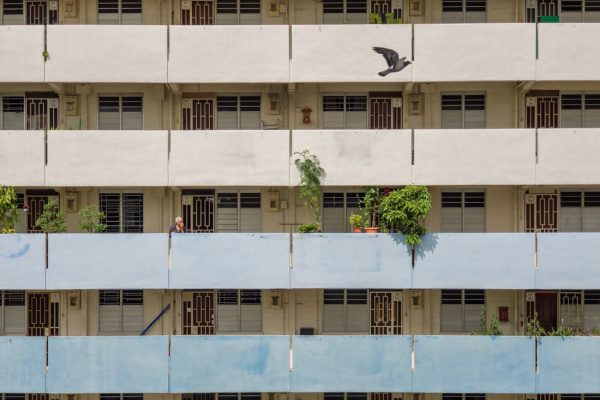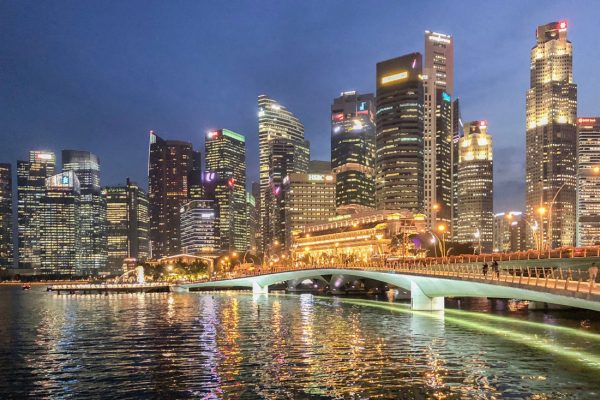In an Indesignlive.sg exclusive, Singapore-based architectural and landscape photographer Darren Soh makes a case for the smartphone camera as the new go-to tool for shooting buildings.

November 10th, 2017
Traditionally, the practice of architectural photography has always been carried out by photographers wielding large, slow, formal and heavy cameras. This was mainly in accordance with the approach to a subject that did not move and accordingly, did not require a fast and small camera in order to capture the best images of said subject.
We are however in the 21st century, and while the formal approach to architectural photography hasn’t changed very much, the tools have hardly remained the same. These days, even the smallest of professional digital cameras produce images rivalling the quality of large-format film made with the old field cameras of yore.
Personally, I have even given up the use of DSLRs, instead opting for smaller and lighter mirrorless 35mm format full-frame cameras that when coupled with tilt-shift lenses, allow me to accomplish 100 per cent of what I am required to do in order to properly photography a building or a space.
In the past, most professional photographers would carry a smaller compact camera with us in order to make scouting images or just so that we have a ‘proper’ camera at our disposal in case a moment or scene comes up that we need to make images of.
Not any more.

These days, most professional photographers would instead be toting the latest and most advanced smartphone instead. This convergence of multiple technologies and abilities into one device that fits in our pockets didn’t happen overnight of course.
Camera phones have been around for nearly two decades now, but it has taken almost all of that time for them to become good enough for professional photographers to consider them as their second or backup camera. Here, in 2017, that moment has indeed arrived.
In the past two-to-three years, the imaging technology going into the camera modules found on smart mobile devices has improved by leaps and bounds. Coupled with how the consumption of architectural images is changing in society, I would argue that the smartphone has become one of the most indispensable tools a modern architectural photographer could have.
Let me explain why.

1. Social Media and Instant Gratification
One of the main platforms for the consumption of architectural images today is Instagram. Yes, print magazines and architectural journals still exist, but most of them would also maintain an Instagram and/or a Facebook account. The quality of images made on the best smartphones today is so good that they can first be instantly processed and uploaded to social media in a matter of minutes after they are made. And because most manufacturers include a more-than-decent resolution (12-20 megapixels) in their cameras, the files can then also be used for print in a magazine thereafter.
2. Small Form Factor
They say the best camera is the one you have with you when the moment or subject you are after unfolds in front of you. What other device is small enough for us to carry at almost all times? Ten years ago, I would carry a small compact point and shoot camera with me in addition to a mobile phone, but today, the camera is the mobile phone.
3. Inherent Qualities of a Smartphone Camera
This may be a no-brainer but hear me out. Most cameras on smartphones are by design equipped with a fairly wide-angle lens that is relatively distortion free. Coupled with a small sensor that is dictated by necessity, (cost and form factor wise) there would be almost limitless depth of field even at a large aperture. This combination makes the smartphone camera an excellent candidate for doing architectural photography.

4. Apps and More Apps
No smartphone is complete without decent apps that can transform a pedestrian smartphone camera into a completely different beast. For both Apple iOS and Android flavours, there are apps that will allow your smartphone to capture in RAW format so as to retain the best quality of the file. There are also apps that will help with perspective control such as SKRWT that allows you to skew and transform your image with little loss in quality, mimicking the use of a tilt shift lens to prevent converging vertical lines in an image.
5. Decent (and Constantly Improving) Low-Light Quality
The Achilles’ Heel for all smartphone cameras is the subpar quality of images made in low light. This is one area where the the laws of physics, which dictate that a larger sensor will always capture more photons than a smaller sensor, have proven to be hard to bend. However, I am not kidding when I say that the smartphone cameras of 2017 have low-light imaging quality that has improved by many times over their 2016 predecessors, so we know that this area is one the manufacturers are putting a lot of their energy into. In fact, 2017’s offerings like the the Apple iPhone X, the Huawei Mate 10 Pro and the Google Pixel 2 promise that vastly improved (and hence usable) low-light images are no longer impossible to achieve and will only get better next year!

At the end of the day, we must however remember that it is still the photographer that makes the photo and not the camera – phone or otherwise.
When it comes to architectural photography and the photography of spaces, there is no substitute for exploration on foot and training oneself to read the quality of light that is falling onto your subjects. Yes, Instagram filters and apps can make a boring or badly composed scene slightly more interesting, but they can never make a lousy image stunning. The (smartphone) camera must continue to be an extension of the photographer as he or she is freed from the limitations of clunky and cumbersome cameras in the search for more images.
All images in this story are © Darren Soh and were made on an Apple iPhone X.
A searchable and comprehensive guide for specifying leading products and their suppliers
Keep up to date with the latest and greatest from our industry BFF's!

The Sub-Zero Wolf showrooms in Sydney and Melbourne provide a creative experience unlike any other. Now showcasing all-new product ranges, the showrooms present a unique perspective on the future of kitchens, homes and lifestyles.

Sub-Zero and Wolf’s prestigious Kitchen Design Contest (KDC) has celebrated the very best in kitchen innovation and aesthetics for three decades now. Recognising premier kitchen design professionals from around the globe, the KDC facilitates innovation, style and functionality that pushes boundaries.

Channelling the enchanting ambience of the Caffè Greco in Rome, Budapest’s historic Gerbeaud, and Grossi Florentino in Melbourne, Ross Didier’s new collection evokes the designer’s affinity for café experience, while delivering refined seating for contemporary hospitality interiors.

Savage Design’s approach to understanding the relationship between design concepts and user experience, particularly with metalwork, transcends traditional boundaries, blending timeless craftsmanship with digital innovation to create enduring elegance in objects, furnishings, and door furniture.

Strategic partner to the INDE.Awards, the Image Makers Association Australia presents a curated offering from its I SHOT 23 exhibition at Craftworks and it’s guaranteed to be a thought-provoking feast for the eye.

We meet Anne Stroud, member of the Image Makers Association of Australia, an organisation that partnered with the 2023 INDE.Awards in two categories.

Meet Dianna Snape in the latest from our series, ‘The Photographers’, another expert adept at framing the essence of architecture and design with her lens.
The internet never sleeps! Here's the stuff you might have missed

We spoke with George Fleck, Vice President and Global Brand Leader of W Hotels, about the intermingling of hotel and hospitality design trends.

Continuing our new series on the design enthusiasts who work in all sorts of different roles across the industry, we speak to Rogerseller’s Claire Drummond.